When you’ve been slouching at your desk for eight hours or more, your body suffers: tight hips and shoulders, a creaky neck and an aching back.
Leaving the office for an actual workout may not be feasible, but with a little yoga, you can reduce discomfort, relieve stress, increase energy and clear your mind — all in a day’s work.
Besides, studies show looking down at a smartphone or screen can add as much as 60 extra pounds of pressure on your spine, so daily stretches can also help you practice good posture.
And before you wonder if getting your ‘om on is possible in business casual, know each of these poses are work-friendly, meaning, you can incorporate them into your daily routine for a quick stretch at any time to feel happier and healthier.
Wrist and Finger Stretch

While sitting, take the fingertips of one hand into the palm of your other hand. Extend that same arm forward, at shoulder-height, and gently pull your fingers down toward the back of your wrist until you feel a slight stretch.
Count to five or 10, then switch hands.
Wrist and Finger Stretch II

Go back to your wrist stretch, but this time, pull each finger individually toward the back of your wrist.
You should feel a slight sensation through your fingers, and keep your arm extended and keep pressing your wrist forward.
Hold for 3-5 breaths, then repeat on the other side.
Seated Tadasana

Reach your arms above your head, stacking wrists over shoulders. Work to straighten your elbows as much as possible, but know it’s okay if there’s a bit of a bend.
You can spread your fingers wide as you think about drawing your thumbs toward the back of your head. Engage your abs as you sit up tall.
Soften your shoulders, stack your head directly over your torso, and lift your chin up and back a tiny bit to help align your spine and find good posture.
Try to stay and breathe for 3-5 slow counts.
Tip: You can also do this pose from a standing position.
Seated Side Stretch

From tadasana, extend your right arm toward the left side of your body, finding as much length as possible from right hip to right armpit.
Palm can face to the left, and gaze can shift up toward your bicep if that feels okay on your neck. Create space between your shoulders and ears.
Tip: Keep your shoulders in line with each other to avoid leaning forward or back — only sideways.
Chair

Bring your feet about hip-width distance apart, and bend your knees. Sit your hips down and back, as you bring the weight of your body to your heels.
Glance down to make sure you can see the tips of your toes; if not, send your hips back an inch or two to protect your knees.
Activate your inner thighs to engage your core, and tilt your torso forward. Arms can reach up (like tadasana), or come together at heart center by pressing palms together.
The Benefit
Hold for 3-5 breaths to strengthen legs, hip flexors and back while stretching your shoulders and chest.
Shoulder Opener
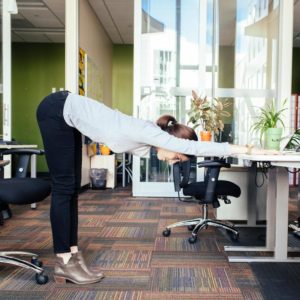
This shoulder stretch variation is easy-to-do at your desk. Move away a few feet, and stand with your feet apart.
Walk your hands forward onto a hard surface, and then imagine your body is forming a right angle.
Keep reaching your hands forward with straight arms until you feel a stretch through your chest, shoulders and upper back.
Don’t worry about your legs — knees can be bent or straight, because this stretch is all about your shoulders.
Hold for 3-5 breaths.
Something Extra
For a more intense shoulder stretch, you can also bring your elbows to the desk, and then bend at the elbows to bring your hands up and back toward the back of your neck.
Forward Fold
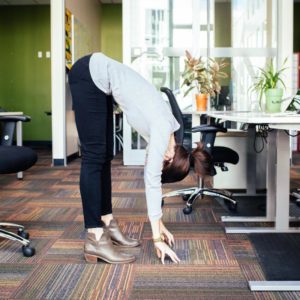
From shoulder stretch, drop your arms to the floor, along with the top of your head.
Fingertips can graze the ground, but if that feels like too much, they can also rest on your shins or knees.
Gently nod your head “yes” and “no” to really release tension in the back of the neck. Keep your weight even or slightly forward into the balls of your feet.
Enjoy the stretch in your hamstrings.
Tip: At the peak of the stretch, welcome several deep breaths to invite calm.
Forward Fold II
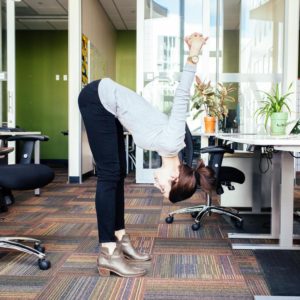
For another option, reach your hands behind your low back to interlace fingertips in a bind.
Press your palms toward each other (don’t worry, they don’t have to touch!) as you raise your wrists away from your back.
Keep tipping your head in the direction of the floor, and release your neck.
Continue to bring your wrists forward, toward your head, as you create more openness through your shoulders and chest.
Forward Fold III
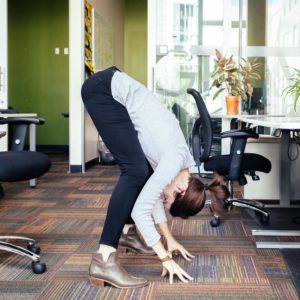
If you’ve got tight hamstrings, here’s a variation of standing forward fold that may work nicely.
Follow the above instructions, but this time, bend your knees as much as you like!
Dancer’s Pose
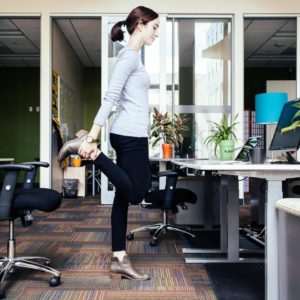
From a standing position, bend your right knee and kick your right heel toward your glutes.
With your right hand, reach back to grab the outside or inside of your right ankle. Stand straight, as if a magnet were lifting your head toward the ceiling, and stack shoulders over hips over ankles.
Press your knee down, and keep the inside of your right knee as close to the inside of your left knee as possible.
Flex through your right foot, toward the back of the room, as you keep sending your knee down with hips straight forward.
You’re looking forward a stretch in the front of your hip flexor and the front of your right hip. (Note: if you feel any pain in your knees, skip this stretch.)
The Benefits
Hold for a few breaths, then repeat with on left side to build flexibility and coordination throughout your lower half.
Desk Chaturanga
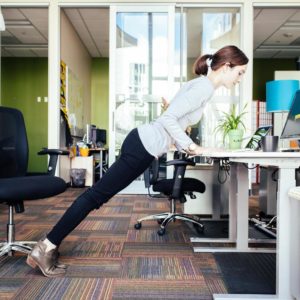
Similar to a push-up, this version of chaturanga tones your wrists, arms, abs and lower back.
The key is to place your body in a long, straight line from head to toe. Lean your body forward from a standing position, and put your hands on a desk or hard surface about shoulder-width apart.
Softly look a few inches in front of your fingertips, and breathe here until you’re ready to push back into a plank position to exit the pose.
Tip: Make sure every inch of your palms is pressing down firmly, and then bend your elbows to ninety degrees, elbows pinned into your sides.
Seated Backbend

From seated, reach your hands a couple inches behind your hips. Push into the chair, and reach your shoulder blades down and back.
Belly is hugged in as chest lifts up and presses forward. Send your gaze up, and if you want, back (but be mindful of your neck!)
Tip: For optimal spinal alignment, keep your feet planted evenly on the ground. Stay for 3-5 breaths.
Seated Twist
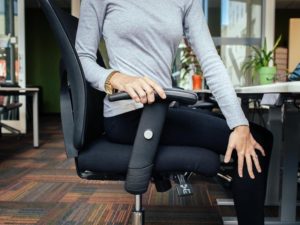
With both knees facing forward, bring your left hand to your outer right knee. Sit up tall and activate your abs. Right hand can rest at your side or down by your right hip.
On every inhale, sit up a little taller, and on every exhale, move your right shoulder back an inch as left shoulder moves forward.
Pull your left hip back as you twist to the right; you want the twist to stay in your lumbar spine.
Also, don’t twist too far; you’ll know you’ve overdone it if it is challenging to keep a steady breath and a tall spine.
You can look toward the right, and eventually toward your right shoulder. Breathe here for a couple of counts, then repeat on the other side, toward the left.
The Benefits
This simple twist promotes good posture, stimulates circulation and aids digestion.
Seated Pigeon

Sitting and tight hips tend to go hand-in-hand, which makes this posture great for unlocking your hip rotators and flexors.
Bring your right knee up to your chest. As you bend through the knee, flex your right foot and start to drop your knee open by rotating your thigh out from your hip joint.
Rest your right ankle on your left thigh, above your left knee. Flex your right foot to protect your knee, and use your right hand to lightly press your right knee down. (Be gentle with your knee here!).
Keep sitting up straight with your left foot flat on the floor. Repeat using your left knee.
Remember
You only need to go as far as the place where you feel some sensation in the stretch; there’s no need to overwork and risk injury.
Namaste
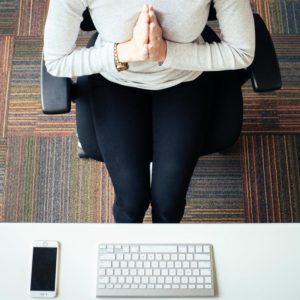
More than anything, yoga is about connecting to your breath — so in addition to these poses, know you can always find a little “namaste” by bringing your hands to heart center, closing your eyes, and taking 5-10 deep breaths before diving back into your work.
Your body, mind and spirit will thank you.



















































